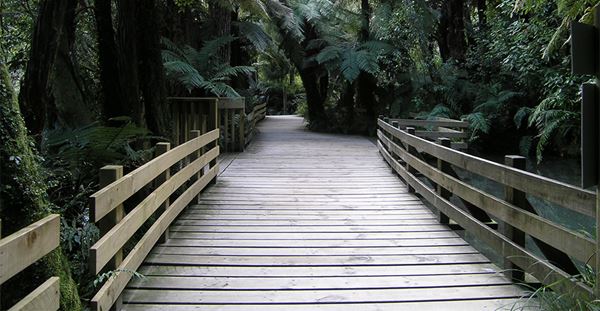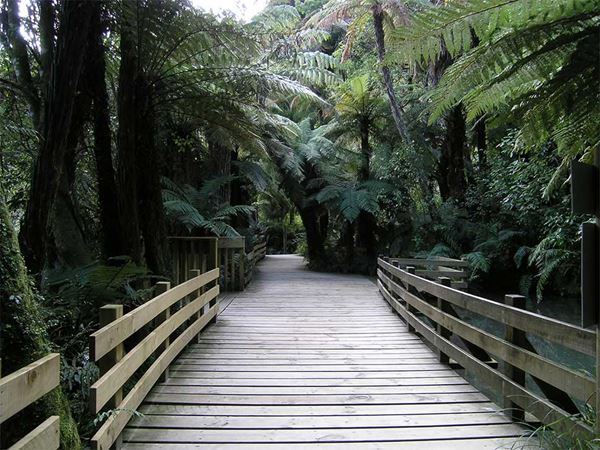Treetops Canopy Walk
Hidden amongst beautiful native bush on the edge of the Mamaku Ranges, a recent addition is our Rainforest Treetops Walk.
A first for Rotorua, the solid boardwalk is up to six metres (20 feet) off the ground in places, putting you right up in the tree canopy.
The elevated walkway winds around mature native Tawa trees several hundred years old, through tangled vines and native plants, before lowering back down to ground level and exiting alongside a peaceful stretch of the Ngongotaha Stream.
Many of the native trees and plants are easily identified with signage - telling of the traditional uses by the Maori people and numerous other interesting facts.
Wild native birds like Tui, Bellbirds, Fantails and Pigeons frequent the bush around the treetops walk. Bird snares (Waka Kereru or Pigeon trough) that were once used by the Maori to attract birds to be captured and eaten, are now used as feeding troughs to attract them further.

Image Caption
Post-Splitters Hut
Replica hut where bushman would have lived deeper in this very same bush of the Mamaku area that edges onto Paradise Valley Springs.
The men that would have lived here would have been splitting Native Red Beech and Totara timber into fence posts, fence battens, mine shafts and firewood. This was done mainly by hand using a maul (like a very large hammer) and wedges.
This particular hut is made out of native Totara posts which is a timber that lasted very well in the ground prior to the availability of timber treatments.

Image Caption.....
Construction of the Treetops
The Treetops canopy walk was finished at the end of December 2007, and took 10 months to construct - virtually by hand. The job was made more difficult due to very limited access and boggy conditions.
Before construction could begin, a temporary gangplank bridge was placed accross the Ngongotaha Stream using a crane to allow foot access to the site. There is no vehicle access whatsoever.
The first task was digging holes down to bedrock for the foundations - in extremely boggy ground, amongst large rocks and tree roots. This was done using hydro excavation (high pressure water to cut through the earth), combined with a vacuum to remove the water and soil slurry. Due to underground water springs, one hole opened up so large, a helicopter was needed to carry in about 100 wheelbarrow loads of earth to fill it.
Metal barrels were then stacked on top of eachother inside the holes to keep the dirt from slipping in. After water was pumped from the holes, concrete was poured in for the foundations and 7 metre long poles weighing 250 kilos each were carried in and bolted upright to the dried concrete.
Wood (Pine) was put to much use on the top of the boardwalk - for beams, joists, braces, handrails and the walkway.
Railway sleepers were used extensively to form staircases both leading up to and again off the high walkway, before a dark concrete path was laid following the contour of the Ngongotaha Stream towards the exit.
Stay in touch
Sign up to receive new offers & promotions
Contact Us